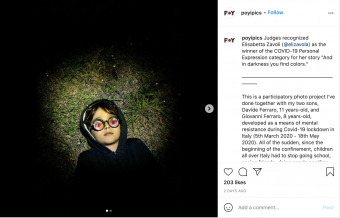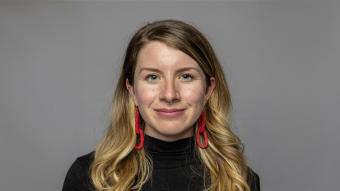March 2, 2021
Contact: Eric Stann, 573-882-3346, StannE@missouri.edu
The views and opinions expressed in this “for expert comment” release are based on research and/or opinions of the researcher(s) and/or faculty member(s) and do not reflect the University’s official stance.

The Pictures of the Year International competition, or POY, is the oldest photojournalism competition in the world. Founded in 1943 at the University of Missouri’s School of Journalism by Cliff Edom, the contest was originally created to honor photojournalists working stateside during World War II. Now, POY works as an educational program, helping connect students to the profession and teaching the value of photojournalism to the public.
POY, now in its 78th year, has adapted during the COVID-19 pandemic to continue its work by operating virtually with an expanded group of judges reviewing a record-breaking number of photo submissions. Lynden Steele, POY director and director of photojournalism at the School of Journalism’s Reynolds Journalism Institute, said several adjustments have been made for this year’s contest.
What are some aspects of this year’s competition that have adjusted due to the COVID-19 pandemic? Have you found anything surprising about these adjustments?
Because of the pandemic, we’ve changed nearly every aspect of POY, including the entry system, how judges vote, how images are displayed to the judges and how the winners are displayed on poy.org.
We’ve now moved to a web-based platform that allows us to operate in a virtual environment. We are grateful for such technology. It means that the five graduate students who would normally meet in person to review and organize the entries, can now do their work remotely and safely.
Additionally, this move supports our efforts to expand and collaborate with the other POY programs — College Photographer of the Year, POY Latam, and POY Asia. We recently founded POY Asia to share daily stories of living in Asia during the COVID-19 pandemic. We are now accepting entries for the inaugural POY Asia photo contest from photographers based in Asia through March 15.
Together, across all POY platforms, we are collaborating to preserve the stories related to the pandemic from across the globe as a reflection of this singular shared experience and moment in history.

The “COVID-19 Personal Expression category” is one of two new categories at this year’s competition, and allows for an “interpretive project.” How did the organizers come up with the idea for this category, and how is it different than in previous competitions?
Each year, POY reflects the news of the year. During the pandemic, we’ve seen many photojournalists who are not only isolated at home, but are also sharing their stories of isolation. Many news organizations have published these autobiographical stories, even though they may not have followed the traditional lines of documentary practice. The works are more interpretive and reflect the photographers’ emotional state in addition to straight forward documentation.
Earlier this year, our sister program POY Latam took the lead in supporting these types of projects. They partnered with the Spanish language edition of The New York Times and published a number of pieces by Latin American photographers, writers and artists. We are inspired by this work and POY Latam’s online magazine that features the work.
POY has always reflected the most important news and issues. The pandemic is only one of three seismic stories this year. The news also was dominated by coverage of the international Black Lives Matter movement and other political events across the globe, including the U.S. presidential election.
2020 was one of those rare years that we all knew it was an historic time while simultaneously experiencing it. Photography allows us to hold on to these moments. And, while our perspective may change through time, the pictures will not. They cannot be rewritten. Years from now, we can look at these images and be instantly transported back to those moments.
Every year, a couple dozen industry professionals are invited to judge at least one category during the three-week competition. In previous years, groups of judges would spend about a week in-person at the Reynolds Journalism Institute reviewing competition entries. This year, the judges are participating virtually due to the pandemic. What challenges has that created, and how has the competition overcome those challenges so far?
This year we nearly doubled the number of judges we invited to review the submissions. Traditionally, four teams of four to five judges — a total of 16-20 people — travel to Mizzou throughout a period of three weeks to discuss the pictures and meet with students. This year, we have seven teams of judges. In total, there are 28 photographers, editors, designers, authors, professors and filmmakers who are volunteering their time to view the entries.
The POY judging sessions this year consist of all-day virtual webinars in which the judges discuss the images and stories in detail. This is the first time the judges are evaluating and voting on the entries before meeting as a group. For the more complex projects, involving up to 40 images on a single topic, it also gives the judges more time to spend with the stories.
The pandemic also changed one of the iconic experiences of POY — voting. For decades, POY judges voted anonymously via a clicker with red and green buttons. Their votes were indicated by a machine that lights up with corresponding red and green lights and a distinctive, mechanical clunk. We all miss that sound! However, when POY began in 1944, the judges didn’t have clickers or machines, they had two pieces of paper with the words “IN” or “OUT.” To vote, they simply held up their sign. In homage to this history, we have mailed “POY lollipops,” pictures of green and red lights for the judges to hold up and indicate their vote.
While we are missing out on the personal interaction, the virtual sessions still give us a great deal of camaraderie and allow students, at times, to have direct conversations with the judges. We also miss treating the judges to favorite local restaurants, but we’ve sent them care packages with ball caps and gifts from local businesses.
POY is a great learning opportunity for both student and professional journalists, and often goes beyond photo techniques by articulating crucial elements of high-caliber reporting.
Editor’s Note: Videos from the judging of this year’s categories can be seen here.
To view Lynden Steele’s bio, please click here. To arrange an interview with Steele, please contact Eric Stann at StannE@missouri.edu or 573-882-3346.



